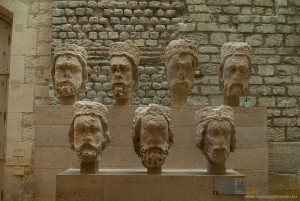7 Gibet de Montfaucon (Gibbet/Gallows of Montfaucon)
53, rue de la Grange aux Belles
Métro: Colonel Fabien
Hours: Not applicable—open to the public.
As you step out of the Metro, you should be facing Place du Colonel Fabien. Turn to your left and cross over Ave. Claude Vellefaux (on your left). The next street on your left will be Rue de la Grange aux Belles—turn left. Walk south until you arrive at no. 53 on your right.
You are standing in front of a garage with apartments built on top—exciting, huh? Seven hundred or so years ago, this was a pretty scary site. You never wanted to end up here.

You’re standing in an area that once was part of the countryside outside the medieval walls of Paris. Standing here, you would have had a pretty good view of the city since you’d be standing on a hill (actually, more like a mound). The hill we now call Montmartre would have been visible to you towards the northwest. Around you would have been the leper colony of St. Lazare, the Convent of the Filles-Dieu (a home for prostitutes), and the original Hôpital Saint-Louis (its modern counterpart is located to the southwest). It seems the king didn’t want any undesirable elements within the walls of the city.
One of the kings’ most undesirable icons stood in front of you. It was the Gibet of Montfaucon. Erected around the late 13th century, the gibbet was used until 1629 and finally dismantled in 1760. The structure was used to hang people and to display the bodies of the executed (both local and imported). There are accounts of the executed being displayed here for more than 3 years before they either exonerated or whatever remained of the body was turned over to the family. The gibbet erected on land once owned by Count Falco (Faucon). Since it was a hill or mound (Mont), the gibbet became known as Montfaucon. Its nickname was “Forks of the great justice.” The best description and image comes from a drawing by Eugène Viollet-le-Duc. It was an imposing 3-sided structure: 20 feet high, 46 feet long, and 39 feet wide. There were 45 “compartments” used to either hang or exhibit the victim’s bodies. Read More Gibet de Montfaucon


